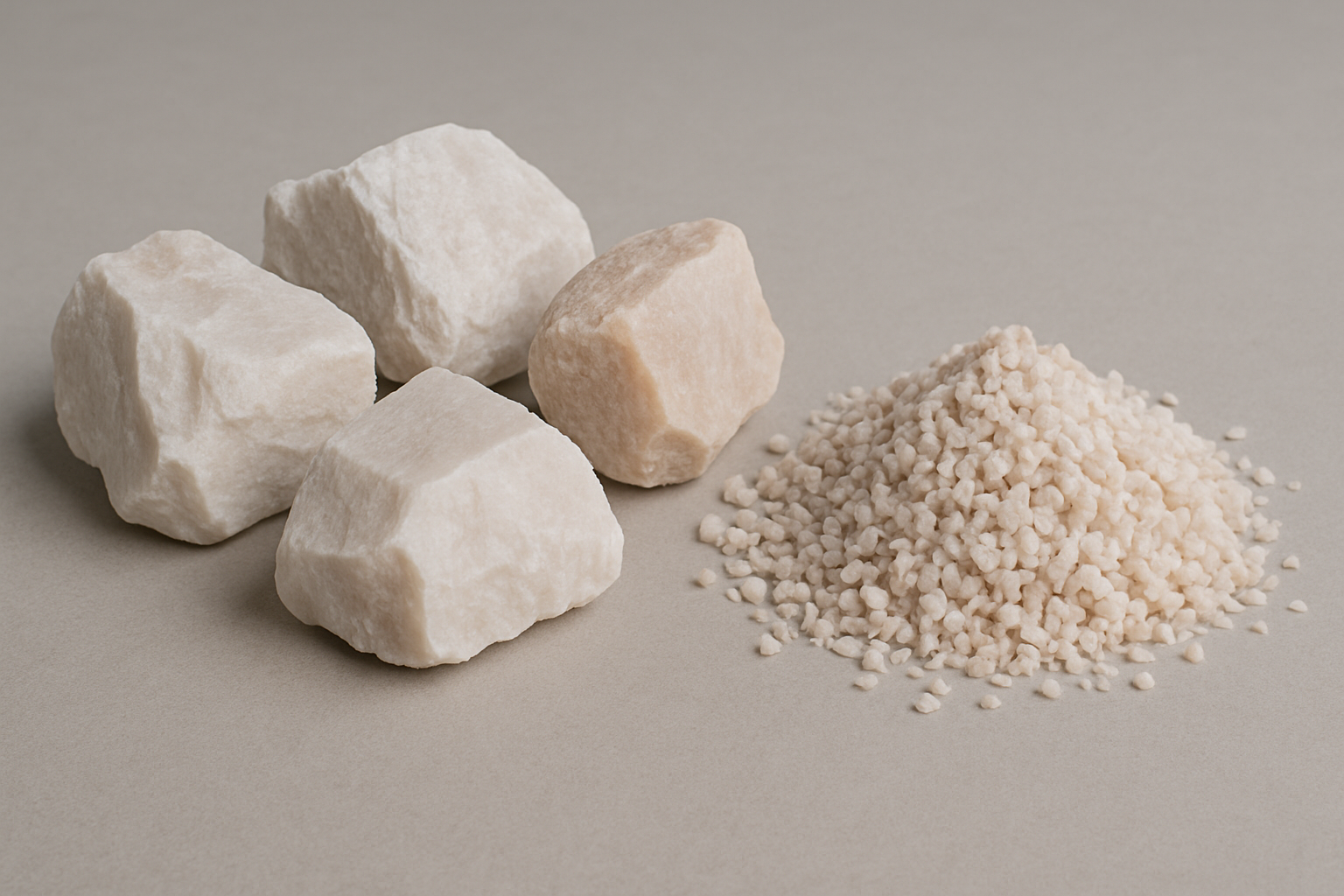Felsbar
Feldspar is a group of common minerals that make up a large proportion of the rocks in the Earth’s crust, estimated to constitute about 60% of its components. Feldspar comes in several types, most notably those containing calcium, potassium, or sodium, and is mainly used in the ceramics and glass industries for its ability to improve the hardness and final appearance of the product.

Features and specifications:
- Feldspar is a group of tectosilicate minerals that make up a large proportion of the rocks found in the Earth's crust. These minerals usually contain calcium, potassium or sodium, and make up more than 50% of the Earth's crust by weight, making them the most abundant minerals.
- Most types of feldspar have a similar hardness on the Mohs scale, making them suitable for a variety of industrial applications.
- They have a distinct vitreous lustre, often pearly on fractured surfaces or crystal faces.

How is feldspar extracted?
The process of extracting feldspar begins with natural sources, where it is often found mixed with other minerals such as quartz or iron. The ore is transported to be sorted manually or through optical sorting techniques, then broken into small pieces and prepared for grinding.
Extraction stage
› Pure feldspar is found in nature, but its minerals often overlap, as potassium feldspar may coexist with sodium feldspar, requiring careful separation processes to obtain the pure product required for various industrial uses.
Crushing stage
› Feldspar ore is sorted manually or using colour sorting techniques, then crushed into small pieces, followed by fine crushing to prepare it for the grinding and processing stage.
Processing stage
› Fluorspar ore undergoes precise purification processes, including strong magnetic separation to remove iron and other magnetic metals, with the aim of improving the purity and quality of the ore before industrial use.
Uses of feldspar
- Fluspar contributes to enhancing the aesthetic appearance of the final product by reducing defects and ensuring a smooth, flawless finish.
- It is widely used in the manufacture of sanitary ware, ceramics, tableware, gifts, electrical products, and enamel.
- In the sanitary ware sector in particular, feldspar helps to facilitate finishing processes and improve surface quality.
Feldspar is considered the second most important component in the ceramics industry after clay, as it is characterized by its ability to melt gradually at different temperatures, without a specific melting point.
- This property is a major advantage, as it helps to accelerate the melting of clay and quartz and allows for precise control during the critical stage of production.
- Feldspar is also used as a fluxing agent for producing glass coatings at low temperatures, and is a source of alumina and alkalis in coating compositions.
- In most cases, it contributes to increasing the hardness of ceramics, as well as their durability and structural strength.
Feldspar is an essential component in glass manufacturing, acting as a fluxing agent.
It helps lower the melting point of quartz while maintaining the appropriate viscosity of the glass during production, thereby improving manufacturing efficiency and the quality of the final product.
Feldspar is used as an effective extender and filler in industries such as paints, rubber, and plastics, thanks to its balanced physical and chemical properties.
These properties include: acid stability, chemical inertness, good dispersion, high refractive index, frost resistance, corrosion resistance, and low viscosity.
Feldspar as gemstones
Some types of potassium feldspar have aesthetic properties and economic value that make them suitable for use as gemstones. Among the most famous of these types are moonstone and amazonite, which are characterised by their attractive colours and unique lustre, and are used in jewellery and ornamental crafts.
Using feldspar in the manufacture of abrasives
Feldspar is used in combination with magnesium oxide, magnesium chloride and other materials in the manufacture of synthetic adhesives, which are an essential component in the production of grinding wheels and abrasives. These compounds help improve the adhesion, strength, and durability of these products, making them effective in industrial polishing and finishing processes.
Using potassium feldspar in welding electrodes
Potassium feldspar is a very useful material for coating welding electrodes, thanks to its physical and chemical properties. They are used in particular in the coating of electrodes for manual arc welding, a method that relies on an electric arc to weld ferrous alloys. This process is used in a variety of industries, such as:
- General manufacturing
- Shipbuilding
- Steel industry

